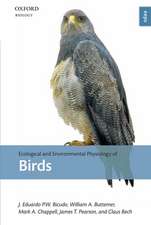Molecular Mechanisms for Repair of DNA: Part A: Basic Life Sciences, cartea 5
Editat de Philip Hanawalten Limba Engleză Paperback – 27 dec 2012
| Toate formatele și edițiile | Preț | Express |
|---|---|---|
| Paperback (2) | 647.59 lei 43-57 zile | |
| Springer Us – 27 dec 2012 | 647.59 lei 43-57 zile | |
| Springer Us – 17 noi 2012 | 647.59 lei 43-57 zile |
Din seria Basic Life Sciences
- 5%
 Preț: 378.07 lei
Preț: 378.07 lei - 15%
 Preț: 647.73 lei
Preț: 647.73 lei - 5%
 Preț: 383.55 lei
Preț: 383.55 lei - 15%
 Preț: 649.06 lei
Preț: 649.06 lei -
 Preț: 401.03 lei
Preț: 401.03 lei - 5%
 Preț: 730.71 lei
Preț: 730.71 lei - 5%
 Preț: 736.92 lei
Preț: 736.92 lei - 5%
 Preț: 726.68 lei
Preț: 726.68 lei - 5%
 Preț: 729.26 lei
Preț: 729.26 lei - 18%
 Preț: 960.61 lei
Preț: 960.61 lei - 5%
 Preț: 375.85 lei
Preț: 375.85 lei - 5%
 Preț: 744.05 lei
Preț: 744.05 lei - 5%
 Preț: 740.58 lei
Preț: 740.58 lei - 5%
 Preț: 733.82 lei
Preț: 733.82 lei - 5%
 Preț: 719.38 lei
Preț: 719.38 lei -
 Preț: 397.59 lei
Preț: 397.59 lei - 5%
 Preț: 390.85 lei
Preț: 390.85 lei - 15%
 Preț: 657.57 lei
Preț: 657.57 lei - 5%
 Preț: 382.99 lei
Preț: 382.99 lei - 5%
 Preț: 400.56 lei
Preț: 400.56 lei - 5%
 Preț: 739.69 lei
Preț: 739.69 lei - 15%
 Preț: 657.25 lei
Preț: 657.25 lei - 18%
 Preț: 959.67 lei
Preț: 959.67 lei -
 Preț: 401.24 lei
Preț: 401.24 lei - 15%
 Preț: 658.88 lei
Preț: 658.88 lei - 5%
 Preț: 387.39 lei
Preț: 387.39 lei - 5%
 Preț: 376.95 lei
Preț: 376.95 lei - 5%
 Preț: 768.39 lei
Preț: 768.39 lei - 5%
 Preț: 735.83 lei
Preț: 735.83 lei - 15%
 Preț: 651.19 lei
Preț: 651.19 lei - 18%
 Preț: 1228.47 lei
Preț: 1228.47 lei - 15%
 Preț: 595.36 lei
Preț: 595.36 lei - 5%
 Preț: 736.39 lei
Preț: 736.39 lei - 5%
 Preț: 730.55 lei
Preț: 730.55 lei - 18%
 Preț: 960.30 lei
Preț: 960.30 lei - 5%
 Preț: 738.93 lei
Preț: 738.93 lei - 15%
 Preț: 662.16 lei
Preț: 662.16 lei - 15%
 Preț: 663.60 lei
Preț: 663.60 lei -
 Preț: 395.25 lei
Preț: 395.25 lei - 5%
 Preț: 739.13 lei
Preț: 739.13 lei - 15%
 Preț: 639.59 lei
Preț: 639.59 lei - 5%
 Preț: 377.52 lei
Preț: 377.52 lei - 5%
 Preț: 721.40 lei
Preț: 721.40 lei - 18%
 Preț: 1241.10 lei
Preț: 1241.10 lei - 18%
 Preț: 1233.69 lei
Preț: 1233.69 lei
Preț: 647.59 lei
Preț vechi: 761.87 lei
-15% Nou
Puncte Express: 971
Preț estimativ în valută:
123.96€ • 134.69$ • 104.19£
123.96€ • 134.69$ • 104.19£
Carte tipărită la comandă
Livrare economică 21 aprilie-05 mai
Preluare comenzi: 021 569.72.76
Specificații
ISBN-13: 9781468428971
ISBN-10: 1468428977
Pagini: 464
Ilustrații: XXIV, 418 p.
Dimensiuni: 152 x 229 x 24 mm
Greutate: 0.62 kg
Ediția:Softcover reprint of the original 1st ed. 1975
Editura: Springer Us
Colecția Springer
Seria Basic Life Sciences
Locul publicării:New York, NY, United States
ISBN-10: 1468428977
Pagini: 464
Ilustrații: XXIV, 418 p.
Dimensiuni: 152 x 229 x 24 mm
Greutate: 0.62 kg
Ediția:Softcover reprint of the original 1st ed. 1975
Editura: Springer Us
Colecția Springer
Seria Basic Life Sciences
Locul publicării:New York, NY, United States
Public țintă
ResearchCuprins
I. Repairable Damage in DNA.- 1. Repairable Damage in DNA: Overview.- 2. The Nature of the Alkylation Lesion in Mammalian Cells.- 3. “Excision” of Bases from DNA Methylated by Carcinogens in Vivo and Its Possible Significance in Mutagenesis and Carcinogenesis.- 4. Alkali-Labile Lesions in DNA from Cells Treated with Methylating Agents, 4-Nitroquinoline-N-oxide, or Ultraviolet Light.- 5. Apurinic and Apyrimidinic Sites in DNA.- 6. Maintenance of DNA and Repair of Apurinic Sites.- 7. DNA Turnover and Strand Breaks in Escherichia coli.- 8. Excision-Repair of ?-Ray-Damaged Thymine in Bacterial and Mammalian Systems.- 9. Formation of Dimers in Ultraviolet-Irradiated DNA.- 10. An Enzymatic Assay for Pyrimidine Dimers in DNA.- II. Enzymatic Photoreactivation.- 11. Enzymatic Photoreactivation: Overview.- 12. Kinetics of Photoreactivation.- 13. Purifying the Escherichia coliPhotoreactivating Enzyme.- 14. The Human Leukocyte Photoreactivating Enzyme.- 15. Photorepair of RNA.- III. Dark Repair in Bacteriophage Systems.- 16. Dark Repair in Bacteriophage Systems: Overview.- 17. Enzymic Mechanism of Excision-Repair in T4-Infected Cells.- 18. The Repair of Ultraviolet Damage by Phage T4: The Role of the Early Phage Genes.- 19. Repair of IIeteroduplex DNA in Bacteriophage T4.- 20. Recovery of Phage ? from Ultraviolet Damage.- IV. Enzymology of Excision-Repair in Bacteria.- 21. Enzymology of Excision-Repair in Bacteria: Overview.- 22. The Escherichia coliUV Endonuclease (Correndonuclease II).- 23. Endonuclease II of Escherichia coli.- 24. Endonuclease III: An Endonuclease from Escherichia coli That Introduces Single Polynucleotide Chain Scissions in Ultraviolet-Irradiated DNA.- 25. An Escherichia coliEndonuclease Which Acts on X-Irradiated DNA.- 26. Substrate Specificity ofMicrococcus luteus UV Endonuclease and Its Overlap with DNA Photolyase Activity.- 27. Two Temperature-Sensitive polA Mutants: An Approach to the Rolein Vivoof DNA Polymerase I.- 28. The Role of DNA Polymerase I in Excision-Repair.- 29. Involvement of Escherichia coliDNA Polymerase-I-Associated 5??3? Exonuclease in Excision-Repair of UV-Damaged DNA.- 30. Exonuclease VII of Escherichia coli.- 31. Enzymatic Repair of UV-Irradiated DNA in Vitro.- 32. Repair Replication in Permeabilized Escherichia coli.- 33. Requirement for uvrAB Function for Postirradiation DNA Synthesis in Vitro.- 34. DNA Polymerase II-Dependent DNA Synthesis in Toluenized Bacillus subtilis Cells.- V. Repair by Genetic Recombination in Bacteria.- 35. Repair by Genetic Recombination in Bacteria: Overview.- 36. Genetic Exchanges Induced by Structural Damage in Nonreplicating Phage ? DNA.- 37. The Beginning of an Investigation of the Role of recF in the Pathways of Metabolism of Ultraviolet-Irradiated DNA in Escherichia coli.- 38. The Degradation of Duplex DNA by the recBC DNase ofEscherichia coli.- 39. Analysis of Temperature-Sensitive recB and recC Mutations.- 40. Recombination and Postreplication Repair.- 41. Ultraviolet-Light-Induced Incorporation of Bromodeoxyuridine into Parental DNA of an Excision-Defective Mutant of Escherichia coli.- 42. Distribution of Pyrimidine Dimers During Postreplication Repair in UV-Irradiated Excision-Deficient Cells of Escherichia coli K12.- 43. Experiments on the Filling of Daughter-Strand Gaps During Post- replication Repair.- 44. Postreplication Repair Gap Filling in an Escherichia coli Strain Deficient in dnaB Gene Product.- 45. Involvement of uvrD, exrA, and recB Genes in the Control of the Postreplicational Repair Process.- 46. Replication and Expression ofConstructed Plasmid Chimeras in Transformed Escherichia coli-A Review.- VI. Relationships Among Repair, Mutagenesis, and Survival.- 47. Relationships Among Repair, Mutagenesis, and Survival: Overview.- 48. SOS Repair Hypothesis: Phenomenology of an Inducible DNA Repair Which Is Accompanied by Mutagenesis.- 49. Thermal Enhancement of Ultraviolet Mutability in a dnaB uvrA Derivative of Escherichia coli B/r: Evidence for Inducible Error-Prone Repair.- 50. lexB: A New Gene Governing Radiation Sensitivity and Lysogenic Induction in Escherichia coli K12.- 51. Indirect Suppression of Radiation Sensitivity of a recA? Strain of Escherichia coli K12.- 52. The Two-Lesion Hypothesis for UV-Induced Mutation in Relation to Recovery of Capacity for DNA Replication.- 53. The Effect of Genes Controlling Radiation Sensitivity on Chemical Mutagenesis in Yeast.- 54. Influence of Repair on the Specificity of Ultraviolet-Induced Reversion of an Ochre Allele of the Structural Gene for Iso- 1-cytochrome c.- 55. The Role of DNA Polymerase I in Genetic Recombination and Viability of Escherichia coli.- 56. The Role of the rec Genes in the Viability of Escherichia coliK12.- Author Index (to Parts A and B).- Subject Index (to Parts A and B).









